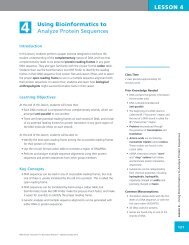WET LAB DNA Barcoding: From Samples to Sequences - Northwest ...
WET LAB DNA Barcoding: From Samples to Sequences - Northwest ...
WET LAB DNA Barcoding: From Samples to Sequences - Northwest ...
Create successful ePaper yourself
Turn your PDF publications into a flip-book with our unique Google optimized e-Paper software.
<strong>WET</strong> <strong>LAB</strong><br />
Wet Lab: Slide #15<br />
26. Tell students that the size of the pores in the <strong>DNA</strong> gel (determined by the<br />
amount of agarose used) influences how quickly (or slowly) the <strong>DNA</strong> will move<br />
through the gel. Scientists usually make agarose gels with 0.8% <strong>to</strong> 2.5%<br />
agarose. Today, students will be making and running a 1% agarose gel.<br />
27. Show Slide #16, which reviews the second step in the process of agarose<br />
gel electrophoresis: sample preparation. A small volume of the PCR product<br />
is mixed with a loading buffer – a concentrated solution containing a dye and<br />
glycerol which makes the <strong>DNA</strong> both visible (which helps you load it on the gel)<br />
and heavy enough <strong>to</strong> sink in<strong>to</strong> the well of the gel. The final volume is achieved<br />
by adding a small amount of water, if needed.<br />
PCR product: The <strong>DNA</strong> copied or<br />
“amplified” during PCR.<br />
Wet Lab: Slide #16<br />
Wet Lab – <strong>DNA</strong> <strong>Barcoding</strong>: <strong>From</strong> <strong>Samples</strong> <strong>to</strong> <strong>Sequences</strong><br />
337<br />
©<strong>Northwest</strong> Association for Biomedical Research—Updated Oc<strong>to</strong>ber 2012
















